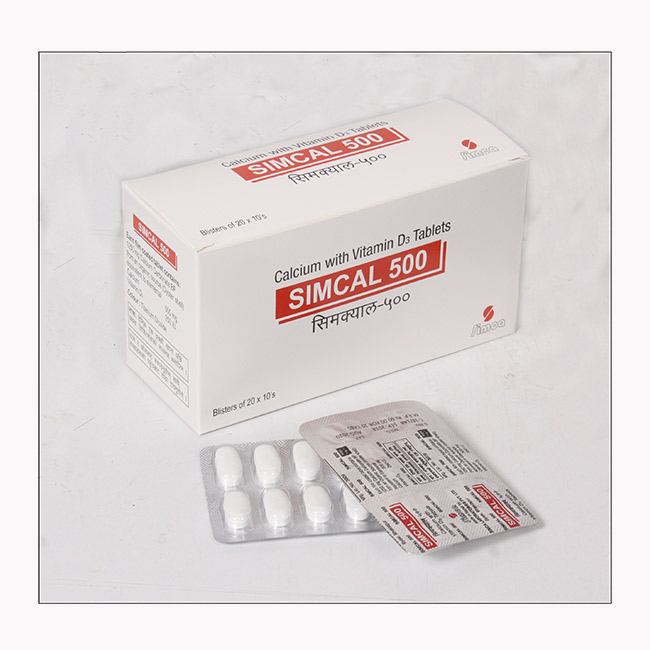Simcal
Generic composition: Calcium 500mg and vitamin D3 250 IU
General Introduction
Simcal; a nutritional supplement contains Calcium and Vit D3. Calcium and Vitamin D3 tablet are much-prescribed mineral and vitamin supplements for various conditions. Simcal contains Oyster Shell 1.250 gm Calcium containing 500 mg of elemental Calcium from Calcium tribasic phosphate and Cholecalciferol (Vit D 3) 250 IU.
Therapeutic Category
- Calcium supplements
Dosage forms available
- SIMCAL Tablets
Pharmacokinetics
Calcium tribasic phosphate:
Calcium is primarily absorbed in the proximal part of the small intestine. The rate of absorption through the gastro-intestinal way is about 30% of the introduced amount. More than 98% of the filtered Ca2+is reabsorbed from tubules to the circulation.
Vit D3 (Cholecalciferol)
Vit D3 is absorbed from the small intestine and is transported by proteinic components in blood to the liver and the kidney. Bile is essential for adequate absorption of vitamin D and thus hepatic or biliary dysfunction seriously impairs Vit D absorption. The primary route of excretion of vitamin D is the bile; only a small percentage of an administered dose is found in urine.
Uses
- Calcium and Vitamin D3 deficiency and increased needs
- Calcium supplementation in pregnancy and lactation
- Osteoporosis, fractures, menopausal women
Dose
- 1 tablet to be taken two times a day, depending on individual requirement of patients
Side effects
- Constipation, Flatulence, Nausea, epigastric pain, diarrhea, calciuria, calcemia.
Contraindications
- Hypersensitivity to either one of the components , Hypercalcaemia, Hypercalciuria
Drug interactions
- Digitalis: the oral calcium administration associated with vitamin D increases the toxicity of digitalis (risk of disorders of the rate/rhythm).
- Thiazide diuretic: a monitoring of the calcium is recommended (reduction in the urinary elimination of calcium).
- Tetracycline: it is recommended to administer at least three hours before/after the administration (possible reduction in the absorption of the tetracycline).
- Phenytoin, barbiturates: possible reduction in the effect of the vitamin D3 by inhibition of its metabolism.
- Glucocorticoids: possible reduction in the effect of the vitamin D3.
Precautions
- Concomitant administration with other calcium containing preparations
- Sarcoidosis: The product must be prescribed with precaution among patients with risk of sarcoidosis because of a possible increase in the metabolism of the vitamin D3 in its active form.
- Renal insufficiency
- Pregnancy: This product can be used during the pregnancy and breast-feeding. However the amount per day should not exceed 1500 calcium mg and 600 i.u. of vitamin D3.
- Breast Feeding: Vit D3 and its metabolites pass into the mother’s milk.
- The overdose results in a Hypocalciuria and a hypocalcaemia whose symptoms are as follows: nausea, vomiting, polydipsia, polyuria, and constipation.
- An overdose in vitamin D3 vitamin can cause vascular calcifications and tissue calcification because of the hypercalcaemia.


